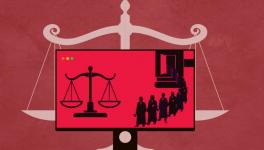Does Twitter Have The Power to Remove Content and Block a User Merely on Complaints?
ACADEMIC discussion on hate speech suggests that what constitutes it depends on its context. Therefore, the outrage expressed by the Delhi High Court’s acting Chief Justice Vipin Sanghi and Justice Navin Chawla on Monday – while hearing a petition seeking the removal of the allegedly objectionable content about Hindu goddess Kali posted on Twitter – seems premature if one considers its context.
Only a few days ago, another bench of the same High Court observed that hate speech – if said with a smile – may not suggest criminality.
The content, posted by a user called @atheistrepublic, appears to have offended a believer, who first asked Twitter to remove it. Twitter’s inaction led this complainant to approach the High Court for relief. The High Court, one can infer, is faced with a plea to block this account, which is alleged to have repeatedly violated Twitter’s guidelines to avoid hateful content.
But the plea has to be legally tested. It can’t be said that the ingredients of Section 295A of the Indian Penal Code – which deals with deliberate and malicious acts intended to outrage religious feelings of any class by insulting its religion or religious beliefs – are attracted in this case, especially if one applies the test of a reasonable person. A ‘reasonable person’ is an ordinary person of common sense and prudence, and not an out-of-ordinary or hypersensitive person. It is not as if the Delhi High Court has formed even a prima facie view that the @athiestrepublic may be guilty of hate speech.
The law on hate speech
In Parvasi Bhalai Sangathan vs. Union of India (2014), the Supreme Court held that the offence of hate speech is not about causing distress to an individual, but about targeting the social standing of persons, qua their membership of groups, in a way that opens them up to hostility, discrimination or even violence. As New Zealander legal philosopher Jeremy Waldron would argue, the aim of hate speech codes is not to protect people from an ‘effect on their feelings’, but to preserve ‘the assurance of their decent treatment in society’.
The portrayal of Kali by @atheistrepublic may, therefore, suggest that while it may have caused anger and hurt among some users of Twitter, it is unlikely to have caused anything beyond that, to attract the ingredients of section 295A, so as to threaten the principles of inclusiveness and dignity of a group of people.
Therefore, certain remarks made by the Delhi High Court’s judges while hearing this case on Monday, appeared to blur the distinction between tolerable criticism or caricature of religion and blasphemy. The court’s observation that Twitter would have been more sensitive had the content been about “another region” or “another religion” might have been influenced by the facts of the case, but when seen in the context of rising intolerance of even the right to livelihood and the pursuit of profession of minorities, it is likely to dismay observers. One only hopes that the Judges were merely responding to the contentions of the parties before them.
Twitter’s action against Donald Trump
Twitter can be accused of not acting fast enough to warn the atheistic organisation, which is accused of repeatedly posting “blasphemous content” about the Hindu deity. The High Court has also asked Twitter to show it the law that states action against offensive tweets can only be taken following a court order.
In a sense, the High Court is probably asking Twitter to explain why it did not remove the content, if alleged as blasphemous by any other user. At the same time, it has asked the Centre to examine the tweets in question and other allegedly offensive posts by the atheistic organisation to see if those could be blocked under Section 69A of the Information Technology [IT] Act. Even the Centre has admitted the legal position that the social media companies can’t violate rights by arbitrarily pulling down content.
The legal position is that reasonable restrictions on freedom of expression can only be imposed under Article 19(2) of the Constitution through a legislative mandate. It is debatable whether the sweeping executive powers over online speech – in the guise of the Blocking Rules framed under section 69A of the IT Act – are legally defensible. But to suggest, as the Delhi High Court did on Monday, that Twitter, on its own, can – in the absence of court orders – restrict or curtail the freedom of speech of its users may be fraught with dangers.
The bench’s questions to Twitter may indeed point to the need for a larger debate on the scope of Twitter’s intervention in such matters. The bench asked: Does Twitter have any obligation on its part to keep a watch on its users to find out if they are posting something offensive? Is Twitter supposed to block an account in case of repeated complaints or only remove content every time there is a complaint?
Twitter has replied to the High Court that it had removed six of @atheistrepublic’s tweets, and a first information report had been registered by the police in Karnataka. But Twitter’s submission that it cannot block an account without a court order seems to have provoked the bench to ask: “If this is the logic, why have you blocked Mr. Trump?”.
The bench asked Twitter to respond whether it cannot use its sense of judgment, when it finds “something absolutely, brazenly blasphemous or brazenly offending the sentiments of the people”.
The bench seems to have been disappointed that Twitter took no action, despite the petitioner complaining about the offensive content as early as on December 9 last year. The court had first directed Twitter to remove the allegedly objectionable content on October 29 last year, by “according importance to people’s sentiments”. Twitter’s inaction appears to have invited harsh comments from the bench.
There can be no debate that Twitter is required to observe due diligence under the new IT Rules, and that its guidelines bar hateful content on its platform.
In the past, Twitter has not complied fully with the Indian government’s statutory orders under Section 69 of the IT Act to block hundreds of accounts for allegedly posting messages suggesting that the Prime Minister, Narendra Modi, was planning a genocide against farmers. Twitter had said then that the government’s blocking list had accounts of journalists, activists and politicians whose accounts appear to be bona fide; that their posts are legitimate expression; and that it reasonably believes that keeping them blocked would be a disproportionate act contrary to both Indian law and the platform’s charter objectives.
As advocate Prasanna S. had pointed out last year, Twitter had suspended the then American President, Donald J. Trump’s Twitter account, as the last step in the series of measures like flagging his content, and limiting its reach. Trump’s account’s permanent ban was the last step, after an appraisal of his Twitter posts’ effect on the Capitol Hill attack last year, and the probability of further imminent lawlessness.
It is arguable, therefore, whether the atheist organisation’s tweets are capable of triggering such lawlessness in India.
The @athiestrepublic’s content on the goddess Kali may not qualify as an artistic work similar to that of eminent painter, M.F. Husain, against whom frivolous complaints were filed, and which were later quashed by the Delhi High Court. But should the Delhi High Court not consider whether an atheist organisation and its followers have the right to spread their beliefs without hurting the sentiments of the believers? Merely asking Twitter to submit to the demands of a few complainants, without examining the merit of their complaints, will be tantamount to legitimising the Heckler’s veto.
Get the latest reports & analysis with people's perspective on Protests, movements & deep analytical videos, discussions of the current affairs in your Telegram app. Subscribe to NewsClick's Telegram channel & get Real-Time updates on stories, as they get published on our website.
























